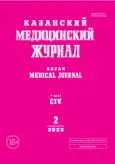Модель мелкоочагового ишемического инфаркта головного мозга как основа для разработки новых методов терапии инсульта
- Авторы: Маркосян В.А.1, Измайлов А.А.1, Соколов М.Е.1, Валиуллин В.В.1, Сафиуллов З.З.1
-
Учреждения:
- Казанский государственный медицинский университет
- Выпуск: Том 104, № 2 (2023)
- Страницы: 242-248
- Тип: Экспериментальная медицина
- URL: https://journals.rcsi.science/kazanmedj/article/view/145682
- DOI: https://doi.org/10.17816/KMJ112404
- ID: 145682
Цитировать
Аннотация
Актуальность. Среди существующих экспериментальных моделей инсульта головного мозга у крупных животных отсутствует возможность создания очагового инфаркта мозга ограниченного объёма, что дало бы возможность как оценить эндогенный потенциал нейрорегенерации, так и установить эффективность новых лекарственных средств на постишемическое ремоделирование мозга.
Цель. Разработка метода моделирования мелкоочагового ишемического инфаркта коры головного мозга у мини-свиньи.
Материал и методы исследования. В исследовании использованы половозрелые самки мини-свиней породы вьетнамские вислобрюхие. Двухуровневую окклюзию магистральных сосудов проводили путём лигирования правой общей сонной артерии и последующего прижигания дистальных ветвей средней мозговой артерии. В послеоперационном периоде оценивали выживаемость животных и неврологический дефицит. На 7-е сутки животных выводили из эксперимента, головной мозг выделяли из черепной коробки. Макроскопическое и микроскопическое исследования включали анализ локализации и площади инфаркта мозга, а также морфологические изменения в инфарктной и периинфарктной областях коры головного мозга.
Результаты. При 100% выживаемости подопытных животных на 3-и сутки после операции неврологический осмотр выявил нарушения кожной чувствительности и мышечного тонуса в задних и передних конечностях, которые частично восстанавливались через неделю после возникновения ишемического инсульта. При макроскопическом исследовании головного мозга на 7-е сутки после операции визуально обнаружен мелкоочаговый ишемический инфаркт мозга в теменной доле левого полушария. Гистологический анализ коры головного мозга выявил некротический очаг ишемического повреждения клиновидной формы. В периинфарктной области мозга обнаружены реактивные тканевые изменения с сохранившимися нервными клетками, в основном без видимых повреждений.
Вывод. Разработанный двухуровневый способ моделирования инсульта у мини-свиньи вызывает ишемический инфаркт головного мозга ограниченного объёма в теменной доле; некритичные гистологические изменения в периинфарктной области и незначительный неврологический дефицит предполагают возможность использования данной модели для разработки новых методов терапии инсульта.
Полный текст
Открыть статью на сайте журналаОб авторах
Ваге Аршалуйсович Маркосян
Казанский государственный медицинский университет
Email: vage.markosyan@gmail.com
ORCID iD: 0000-0002-3789-0284
асс., каф. оперативной хирургии и топографической анатомии
Россия, г. Казань, РоссияАндрей Александрович Измайлов
Казанский государственный медицинский университет
Автор, ответственный за переписку.
Email: andrei.izmaylov@kazangmu.ru
ORCID iD: 0000-0002-8128-4636
SPIN-код: 9629-8511
Scopus Author ID: 7004952364
ResearcherId: R-1143-2017
канд. мед. наук, асс., каф. гистологии, цитологии и эмбриологии
Россия, г. Казань, РоссияМихаил Евгеньевич Соколов
Казанский государственный медицинский университет
Email: supermihon@yandex.ru
ORCID iD: 0000-0003-2938-6683
канд. мед. наук, асс., каф. оперативной хирургии и топографической анатомии
Россия, г. Казань, РоссияВиктор Владимирович Валиуллин
Казанский государственный медицинский университет
Email: valiullinvv@yandex.ru
ORCID iD: 0000-0002-6030-6373
докт. биол. наук, проф, каф. гистологии, цитологии и эмбриологии
Россия, г. Казань, РоссияЗуфар Зуфарович Сафиуллов
Казанский государственный медицинский университет
Email: redblackwhite@mail.ru
ORCID iD: 0000-0003-4577-3448
канд. мед. наук, доц., каф. нормальной анатомии
Россия, г. Казань, РоссияСписок литературы
- Скворцова В.И., Алексеева Г.С., Трифонова Н.Ю. Анализ медико-организационных мероприятий по профилактике инсультов и реабилитации постинсультных состояний на современном этапе. Социальные аспекты здоровья населения. 2013;(1):2. EDN: PYFSMP.
- Campbell BCV, De Silva DA, Macleod MR, Coutts SB, Schwamm LH, Davis SM, Donnan GA. Ischaemic stroke. Nat Rev Dis Prim. 2019;5(1):70. doi: 10.1038/s41572-019-0118-8.
- Mendelson SJ, Prabhakaran S. Diagnosis and management of transient ischemic attack and acute ischemic stroke: A review. JAMA. 2021;325(11):1088–1098. doi: 10.1001/jama.2020.26867.
- Barthels D, Das H. Current advances in ischemic stroke research and therapies. Biochim Biophys Acta Mol Basis Dis. 2020;1866(4):165260. doi: 10.1016/j.bbadis.2018.09.012.
- Li Y, Zhang J. Animal models of stroke. Anim Model Exp Med. 2021;4(3):204–219. doi: 10.1002/ame2.12179.
- Соколов М.Е., Баширов Ф.В., Сафиуллов З.З. Экспериментальное обоснование генной терапии ишемического инсульта головного мозга. Казанский медицинский журнал. 2017;98(5):763–769. doi: 10.17750/KMJ2017-763.
- Melià-Sorolla M, Castaño C, Degregorio-Rocasolano N, Rodríguez-Esparragoza L, Dávalos A, Martí-Sistac O, Gasull T. Relevance of porcine stroke models to bridge the gap from pre-clinical findings to clinical implementation. Int J Mol Sci. 2020;21(18):6568. doi: 10.3390/ijms21186568.
- Wernersson R, Schierup MH, Jørgensen FG, Gorodkin J, Panitz F, Staerfeldt HH, Christensen OF, Mailund T, Hornshøj H, Klein A, Wang J, Liu B, Hu S, Dong W, Li W, Wong GKS, Yu J, Wang J, Bendixen C, Fredholm M, Brunak S, Yang H, Bolund L. Pigs in sequence space: A 0.66X coverage pig genome survey based on shotgun sequencing. BMC Genomics. 2005;6:70. doi: 10.1186/1471-2164-6-70.
- Dalgaard L. Comparison of minipig, dog, monkey and human drug metabolism and disposition. J Pharmacol Toxicol Methods. 2015;74:80–92. doi: 10.1016/j.vascn.2014.12.005.
- Sakoh M, Røhl L, Gyldensted C, Gjedde A, Ostergaard L. Cerebral blood flow and blood volume measured by magnetic resonance imaging bolus tracking after acute stroke in pigs: Comparison with [(15)O]H(2)O positron emission tomography. Stroke. 2000;31(8):1958–1964. doi: 10.1161/01.str.31.8.1958.
- Imai H, Konno K, Nakamura M, Shimizu T, Kubota C, Seki K, Honda F, Tomizawa S, Tanaka Y, Hata H, Saito N. A new model of focal cerebral ischemia in the miniature pig. J Neurosurg. 2006;104(2):123–132. doi: 10.3171/ped.2006.104.2.123.
- Sommer CJ. Ischemic stroke: Experimental models and reality. Acta Neuropathol. 2017;133(2):245–261. doi: 10.1007/s00401-017-1667-0.
- Graham SM, McCullough LD, Murphy SJ. Animal models of ischemic stroke: Balancing experimental aims and animal care. Comp Med. 2004;54(5):486–496. PMID: 15575362.
- Larson ST, Wilbur J. Muscle weakness in adults: Evaluation and differential diagnosis. Am Fam Physician. 2020;101(2):95–108. PMID: 31939642.
- Paul S, Candelario-Jalil E. Emerging neuroprotective strategies for the treatment of ischemic stroke: An overview of clinical and preclinical studies. Exp Neurol. 2021;335:113518. doi: 10.1016/j.expneurol.2020.113518.
- Sokolov ME, Bashirov FV, Markosyan VA, Povysheva TV, Fadeev FO, Izmailov AA, Kuztetsov MS, Safiullov ZZ, Shmarov MM, Naroditskyi BS, Palotás A, Islamov RR. Triple-gene therapy for stroke: A proof-of-concept in vivo study in rats. Front Pharmacol. 2018;9:111. doi: 10.3389/fphar.2018.00111.
Дополнительные файлы






